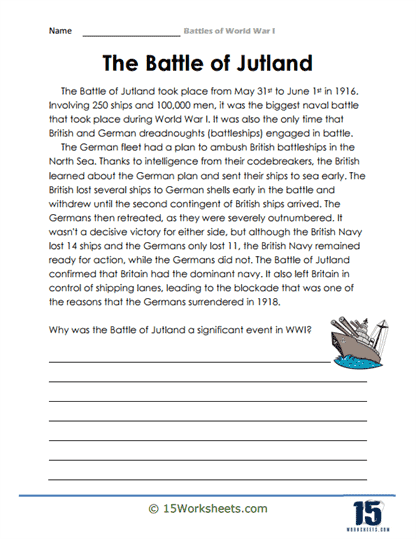Battle of Jutland

Worksheet Description
The worksheet presents an overview of the Battle of Jutland, a significant naval confrontation that occurred from May 31st to June 1st in 1916 during World War I. Engaging 250 ships and 100,000 men, this battle stands out as the largest naval clash of the war, uniquely featuring both British and German dreadnoughts (battleships). The narrative recounts Germany’s initial ambush plan, the British Navy’s early deployment due to decoded intelligence, and the subsequent outcomes where neither side achieved a decisive victory. Nonetheless, the battle’s aftermath reinforced Britain’s naval dominance, a factor that eventually contributed to Germany’s 1918 surrender due to a blockade.
To effectively navigate this worksheet, students should begin by meticulously reading the given information, ensuring they grasp the magnitude, strategies, and outcomes associated with the Battle of Jutland. Emphasis should be placed on understanding the key tactical moves, such as the German ambush plan and the British early deployment due to their intelligence advantage. After digesting the primary events and outcomes, students should turn their attention to the question at the bottom, contemplating the broader significance of the battle in the context of World War I. Their answer should weave details from the text to provide a comprehensive and evidence-based response.
The essence of this worksheet is to instill students with a nuanced understanding of World War I’s pivotal naval battles, using the Battle of Jutland as a central example. Through this lens, learners can appreciate the strategic intricacies of naval warfare, the role of intelligence in shaping outcomes, and the long-term repercussions of major confrontations. By emphasizing the balance of power in the aftermath, where Britain’s maritime dominance was solidified, students can infer the strategic implications of naval battles on broader war outcomes.
